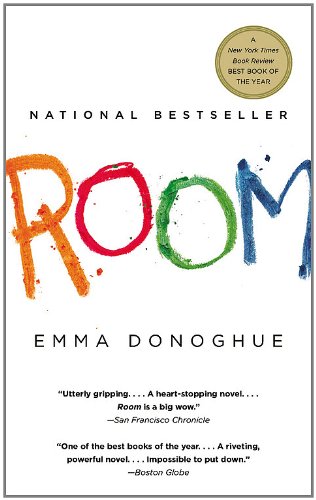One of the thrills of reading is the freedom to be pulled into a world where you are a visitor, but can feel like a native as you get lost in the experiences of the story. This journey often immerses us in characters and places we can identify with and feel comfortable sharing in their visions and emotions. However, when the story is being told from a viewpoint we may not even have known existed, what happens? The novel “Room” by Emma Donoghue explores this intriguingly unfamiliar space by placing readers in the mind of a five year-old child, and that is only the beginning.
Readers enter Room through the eyes, thoughts and facts of young Jack. It is his fifth birthday, and he is full of as much excitement as any young child on their birthday. His present from Ma is a drawing she made of him while he slept, so he hangs the drawing on Wardrobe. The rest of the day is spent doing various activities according to Time. Jack and Ma read one of the five or six books on Shelf, or watch one of the three channels on TV, or do PhysEd by stacking Table and Chair onto Bed and running around the small space.
Every day is the same schedule more or less as Jack and Ma keep each other entertained with what little they have, and through deciding what to ask Old Nick to bring them for Sunday Treat. At 9 p.m. exactly, Jack goes into Wardrobe while Ma gets into Bed after turning off Lamp, and they wait to see whether or not Old Nick will visit Ma that night.
By this time, readers are starting to get uneasy and suspicious of what is truly going on. It seems a bit odd that even after a quite a few chapters, the story is still completely revolving around Room. It is clear that Room is the place where Ma has lived for years, the place where Jack was born, and that Room is literally Jack’s entire world. He sees a small patch of Outside through Skylight in the ceiling, but nothing else is real to him because he can’t comprehend what he doesn’t know or understand.
Soon, Ma begins trying to explain to Jack what the Outside is like, including the fact that there are other people living in the world with all the excitement he sees on TV such as stores, cars, shoes and doctors. Jack is caught in a state of disbelief and fear, especially when Ma begins to plan a way to help Jack escape from Room and Old Nick.
The story crafted by Donoghue is undoubtedly captivating. In many ways Jack’s perspective of life is jarring, as his use of stilted language combats the cheery and bright tone he uses when describing Room. His knowledge, speaking and memorization skills surpass those expected of a five-year-old child and almost make readers forget his containment when getting caught up in his sense of normalcy.
Donoghue makes this unusual story seem like an authentic reality while always instilling feelings of happiness and contentment within Jack’s viewpoint. The book itself is split into five parts, and readers remain in Jack’s mind and thoughts the entire time.
“Room” is a compelling novel as it forces readers to step into a world they know nothing of and cannot easily or commonly connect to.
Another element of emphasis and importance is given to this story once readers are hit with the realization that though this book is fiction, it was based on true stories. Those stories occur in various forms in many places, displaying the existence and horror of such crimes. Young women, men and children have been held prisoner in terrible living conditions, inside or underground and had children born into the hostile environment. Though “Room” is a story of both sadness and triumph, it is also a story of innocence, knowledge and literally learning to see the world in a new light.











